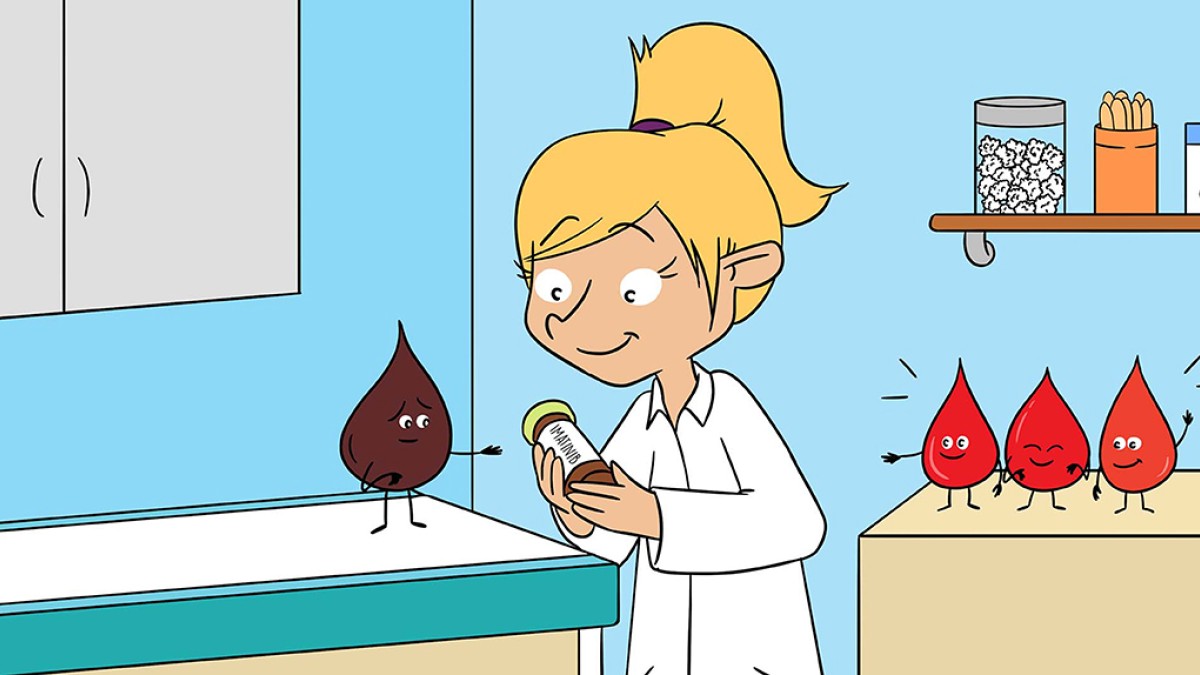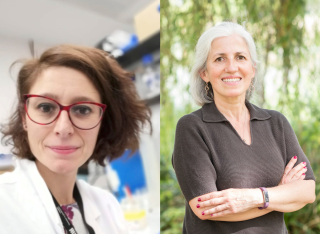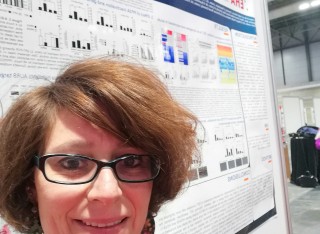
Dr Maria Teresa Esposito
Academic and research departments
School of Biosciences, Section of Immunology, Section of Oncology.About
Biography
I am a molecular biologist and my research interest spans from cancer biology to ageing.
- 2023- Senior Lecturer in Biochemistry, University of Surrey, School of Biosciences, Department of Biochemical Sciences
- 2017-2023- Senior lecturer Biomedical Science (cancer biology), University of Roehampton, School of Life and Health Sciences (UK)
- 2015-2017- Lecturer in Biomedical Sciences (cancer biology), University of East London, School of Health and Sport Sciences (UK)
- 2010-2015- Postdoctoral Researcher, Leukaemia and Stem Cell Biology group headed by Prof Eric So, Department of haematological medicine, King’s College London (UK)
- 2009-2010 - Postdoctoral Researcher, Leukaemia and Stem Cell Biology group headed by Prof Eric So, Department of onco-haematology, Institute of cancer Research, Sutton (UK)
- 2008-2009- Visiting PhD student, Bone and stem cells group headed by Dr Nicole Horwood and Prof Francesco Dazzi, Kennedy Institute of Rheumatology, Imperial College London (UK)
- 2005-2009- PhD student, Gene and Stem cell therapy team headed by Prof Lucio Pastore, CEINGE Biotecnologie Avanzate, Napoli (Italy)
- 2001-2205- Intern student, Gene and Stem cell therapy team headed by Prof Lucio Pastore, Department of Biochemistry and Medical Biotecnologies, University of Napoli Federico II, Napoli (Italy)
My qualifications
Distinction.
110/110 cum laude (First Class).
Affiliations and memberships
News
In the media

ResearchResearch interests
My research interests are in the field of cancer biology and ageing. My research focuses on studying the signalling pathways involved in the development and drug resistance, identification of disease molecular signature and development of novel targeted therapy for Acute Myeloid Leukaemia. I have received funding from Leukaemia UK, the British Society of Haematology and the Institute of Biomedical Science.
I started my independent research group at the University of Roehampton in 2017, when I was awarded the John Goldman fellowship funded by Leukaemia UK. There my group, in collaboration with Queen Mary University of London, the University of Chester and the University of Napoli Federico II, started to investigate the impact of tumor suppressor Ser-Thr protein phosphatase PP2A and its endogenous inhibitors in Acute Myeloid Leukaemia (AML). We discovered that PP2A endogenous inhibitor SET is over-expressed in AML patients and that elevated expression of SET is correlated with poor prognosis and with the expression of MEIS and HOXA genes, which are key downstream targets of KMT2A oncofusion proteins, chromosomal rearrangements found in paediatric, adult and therapy-related AML. More importantly we showed that silencing SET abolished the clonogenic ability of KMT2A-rearranged leukaemic cells and the expression of HOXA9 and HOXA10, identifying SET as critical for the survival of KMT2A-r leukemic cells. Phospho-proteomic analyses revealed that pharmacological inhibition of SET reduced the activity of kinases regulated by PP2A supporting the hypothesis of a feedforward loop among PP2A, AURB, PLK1, MYC, and SET. Overall, this study, published in Oncogene in 2023, illustrates that SET is a novel player in KMT2A-r leukaemia and it provides evidence that re-activation of PP2A via SET antagonism could serve as a novel strategy to treat this aggressive leukaemia.
Prior to this, I conducted my PhD research at the European School of Molecular Medicine-CEINGE in Napoli, there I characterized a rare population of stem cells within the mouse bone marrow, the mesenchymal stromal cells (BMSCs), investigating their self-renewal, differentiation and tumourigenic potential. To pursue my interest in the biology of stem cells and the molecular events underlying their transformation in cancer stem cells, I then joined as post-doc the team of Prof. Eric So at the Institute of Cancer Research, and eventually moved to King’s College London in 2010 when the group transferred there. At King’s I studied the molecular pathways required for establishment and maintenance of leukaemia stem cells, contributing to validate Beta Catenin as a new therapeutic target for KMT2A-r leukaemia through genetic (Knock out mice) and functional (shRNA) approaches. Building on these skills I established my own research domain within the team, working on how to exploit DNA damage repair defects to target leukemic stem cells while sparing the normal ones, an exciting and emerging field in leukaemia therapeutics. This work led to the identification of an unprecedented role for the homeodomain gene HOXA9 in DNA damage repair and as a mediator of Poly ADP-ribose Polymerase (PARP) inhibitor resistance in KMT2A-r leukaemia. A patent was filed in the UK in 2014 and a manuscript published in Nature Medicine in 2015.
My technical expertise spans from cellular and molecular biology techniques to histology, microscopy and flow cytometry. I have expertise in target validation and pre-clinical evaluation of drugs in leukaemia models in vivo, ex vivo (Patient Derived Xenotransplants in 3D culture) and in vitro (cell lines, co-cultures).
I have supervised post-docs, PhD, MSc, MRes and undergraduate students in this area of research.
Indicators of esteem
Member of UKRI Talent Peer Review College (PRC)
Member of the British Society of Haematology Research committee
Nominated for the Biochemical Society Inspiration and Resilience award 2025
Research interests
My research interests are in the field of cancer biology and ageing. My research focuses on studying the signalling pathways involved in the development and drug resistance, identification of disease molecular signature and development of novel targeted therapy for Acute Myeloid Leukaemia. I have received funding from Leukaemia UK, the British Society of Haematology and the Institute of Biomedical Science.
I started my independent research group at the University of Roehampton in 2017, when I was awarded the John Goldman fellowship funded by Leukaemia UK. There my group, in collaboration with Queen Mary University of London, the University of Chester and the University of Napoli Federico II, started to investigate the impact of tumor suppressor Ser-Thr protein phosphatase PP2A and its endogenous inhibitors in Acute Myeloid Leukaemia (AML). We discovered that PP2A endogenous inhibitor SET is over-expressed in AML patients and that elevated expression of SET is correlated with poor prognosis and with the expression of MEIS and HOXA genes, which are key downstream targets of KMT2A oncofusion proteins, chromosomal rearrangements found in paediatric, adult and therapy-related AML. More importantly we showed that silencing SET abolished the clonogenic ability of KMT2A-rearranged leukaemic cells and the expression of HOXA9 and HOXA10, identifying SET as critical for the survival of KMT2A-r leukemic cells. Phospho-proteomic analyses revealed that pharmacological inhibition of SET reduced the activity of kinases regulated by PP2A supporting the hypothesis of a feedforward loop among PP2A, AURB, PLK1, MYC, and SET. Overall, this study, published in Oncogene in 2023, illustrates that SET is a novel player in KMT2A-r leukaemia and it provides evidence that re-activation of PP2A via SET antagonism could serve as a novel strategy to treat this aggressive leukaemia.
Prior to this, I conducted my PhD research at the European School of Molecular Medicine-CEINGE in Napoli, there I characterized a rare population of stem cells within the mouse bone marrow, the mesenchymal stromal cells (BMSCs), investigating their self-renewal, differentiation and tumourigenic potential. To pursue my interest in the biology of stem cells and the molecular events underlying their transformation in cancer stem cells, I then joined as post-doc the team of Prof. Eric So at the Institute of Cancer Research, and eventually moved to King’s College London in 2010 when the group transferred there. At King’s I studied the molecular pathways required for establishment and maintenance of leukaemia stem cells, contributing to validate Beta Catenin as a new therapeutic target for KMT2A-r leukaemia through genetic (Knock out mice) and functional (shRNA) approaches. Building on these skills I established my own research domain within the team, working on how to exploit DNA damage repair defects to target leukemic stem cells while sparing the normal ones, an exciting and emerging field in leukaemia therapeutics. This work led to the identification of an unprecedented role for the homeodomain gene HOXA9 in DNA damage repair and as a mediator of Poly ADP-ribose Polymerase (PARP) inhibitor resistance in KMT2A-r leukaemia. A patent was filed in the UK in 2014 and a manuscript published in Nature Medicine in 2015.
My technical expertise spans from cellular and molecular biology techniques to histology, microscopy and flow cytometry. I have expertise in target validation and pre-clinical evaluation of drugs in leukaemia models in vivo, ex vivo (Patient Derived Xenotransplants in 3D culture) and in vitro (cell lines, co-cultures).
I have supervised post-docs, PhD, MSc, MRes and undergraduate students in this area of research.
Indicators of esteem
Member of UKRI Talent Peer Review College (PRC)
Member of the British Society of Haematology Research committee
Nominated for the Biochemical Society Inspiration and Resilience award 2025
Supervision
Postgraduate research supervision
Former lab members
- Dr Yoana Arroyo (post-doctoral research associate 2018-2020; currently senior staff scientist at The Francis Crick Institute London)
- Miss Antonella Di Mambro (PhD candidate 2017-2021; awarded a PhD in 2021, currently Senior Scientist at Crown Bioscience)
- Miss Immacolata Zollo (visiting PhD student 2022; currently post-doctoral researcher at Universidade de Lisboa Instituto de Biossistemas e Ciências Integrativas, Portugal)
- Miss Mariateresa Zanobio (visiting PhD student 2018; currently post-doctoral researcher at University of Campania Luigi Vanvitelli, Italy)
Current lab members
- Miss Aniko Papp (PhD student funded by CCLG/Little Princess Trust, co-supervised with Dr Lisie Meira)
Miss Alexandra Louise Shanahan (PhD student funded by partnership with University of Wollongong, co-supervised with Prof Carolyn Dillon, Dr Haibo Hu and Dr Lisie Meira)
Teaching
I started teaching in Higher Education during my PhD. I am very passionate about widening opportunities in academia and I work hard to help my students to build knowledge, competence and confidence to pursue their own careers. I obtained a Postgraduate Certificate in Teaching and Learning in Higher Education in 2017, when I was also awarded Fellowship of the Higher Education Academy. In 2017 I was nominated as best dissertation supervisor at the University of East London. In 2018 I was nominated for the Royal Society of Biology Higher Education Bioscience Teacher of the year. In 2023 I was nominated for the UR amazing award at the University of Roehampton.
BMSM020 Molecular Medicine (Module leader)
BMS3063 Cancer Pathogenesis and therapeutics
BMS1030 Biochemistry
BMS1041 Biochemistry
BMS2035 Biochemistry
BMSM027 MSci Research project (student supervision)
BMS3048 BSc Dissertation project (student supervision)
Sustainable development goals
My research interests are related to the following:

Publications
Background and Purpose Activation of Protein Phosphatase 2A (PP2A), via genetic and pharmacologic modulation of SET, has recently being identified as a promising strategy to therapeutically target acute myeloid leukaemia (AML) carrying KMT2A (MLL) chromosomal translocations (KMT2A-r AML). Experimental Approach In this study, we investigated the expression of PP2A subunits and the therapeutic potential of forskolin, a cyclic adenosine monophosphate (cAMP) elevating natural compound that has been reported as a PP2A activator. Key Results Our data show that PPP2CA encoding protein phosphatase 2 catalytic subunit α is abundantly expressed in KMT2A-r AML cells. Treatment with forskolin arrests proliferation; induces cell death; represses the expression of MYC, HOXA9 and HOXA10; stimulates PP2A activity; and attenuates the activity of ERK1/2 in KMT2A-r AML cells. Forskolin increases sensitivity to standard-of-care daunorubicin in KMT2A-AML cell lines and PDX. Silencing PPP2CA partially rescues the cytotoxic effect of forskolin, stimulates ERK1/2, inhibits GSK3β, and abolishes the forskolin-mediated repression of c-MYC and HOXA10, but it did not affect the potentiation of response to daunorubicin. This effect was also not dependent on increase of cAMP, but it was because of increase in the intracellular accumulation of daunorubicin, through inhibition of drug efflux pump P-glycoprotein 1 (multidrug resistance protein). Conclusions and Implications In conclusion, our findings highlight a novel mechanism of action for forskolin and support a potential role of this natural compound in combination with current conventional agent daunorubicin in the treatment of KMT2A-r AML.
Background: Mixed Lineage Leukemia (MLL) is an aggressive form of acute leukemia caused by chromosomal translocation involving the MLL gene at locus 11q23. Despite novel therapeutic approaches, there are no efficient targets for MLL treatments and patients present a very poor prognosis. PP2A is a serine‐threonine phosphatase that downregulates crucial target proteins such as Akt, Erk, and c‐Myc, responsible for proliferation and survival of MLL leukemic cells. De‐regulation of PP2A is a recurring event in many cancers. SET is an endogenous binding partner of PP2A mostly localised in the nucleus. In many diseases including cancer, PP2A inactivation is attributed to cytoplasmic accumulation of SET which inhibits PP2A through direct interaction with PP2A catalytic subunit. FTY720, a sphingosine analogue drug, prevents the formation of SET‐PP2A complex, binding SET and rescuing PP2A activity (Pippa et al., 2014). Aims: To determine the role of SET‐mediated inactivation of PP2A in MLL, in order to define whether this might be an axis amenable to therapeutic target. Methods: The study is performed in vitro using a set of MLL cell lines (n = 8) and primary samples (n = 8). SET gene expression and protein level profile were investigated by real time PCR and Western blot. We analysed SET localization by nucleus‐ cytoplasm separation assay and SET‐PP2A interaction by co‐immunoprecipitation assay. The effect of FTY720 on human cell lines was evaluated by analysis of survival by Trypan Blue exclusion and phosphorylation of PP2A targets by Western blot. Results: Analysis of SET gene expression did not show any significant difference between MLL cell lines and primary samples compared to healthy bone marrow samples. In contrast, SET protein levels were selectively increased in MLL primary samples and cell lines. Analysis of nuclear and cytosolic extracts in MLL cell lines showed that SET was mostly localised into the cytoplasm. Furthermore, immunoprecipitation experiments showed that in MLL cell lines SET is phosphorylated on a serine residue. This modification has been previously shown to be crucial for PP2A binding and inhibition. We evaluated the effect of FTY720 on MLL survival and growth of BCR‐ABL+ cell line K562 by trypan blue exclusion. The results indicate an IC50 ranging from 1.6 to 4.2 μM. The effects of FTY720 on PP2A was evaluated by analysing the phosphorylation of PP2A targets (Akt, Erk, GSK3) in MLL cell lines 24 and 48 hours after treatment. Preliminary data showed no significant changes in phosphorylation of the above targets. These results may suggest that targeting SET alone might not be sufficient to rescue the activity of PP2A in MLL and that redundant mechanisms might occur. The effect of potential combination of FTY720 and standard chemotherapy treatment will be evaluated in future studies. Summary/Conclusion: We showed for the first time that SET is overexpressed in MLL samples and mostly localised into the cytoplasm. Given the implication of SET as an endogenous PP2A inhibitor, we aim to understand the mechanism by which it interacts with PP2A in MLL to target this complex with the aim of designing novel therapeutic approaches for this challenging disease.
The use of adult stem cells in tissue engineering approaches will benefit from the establishment of culture conditions that allow the expansion and maintenance of cells with stem cell–like activity and high differentiation potential. In the field of adult stem cells, bone marrow stromal cells (BMSCs) are promising candidates. In the present study, we define, for the first time, conditions for optimizing the yields of cultures enriched for specific progenitors of bone marrow. Using four distinct culture conditions, supernatants from culture of bone fragments, marrow stroma cell line MS-5, embryonic fibroblast cell line NIH3T3, and a cocktail of epidermal growth factor (EGF) and platelet-derived growth factor (PDGF), we isolated four different sub-populations of murine BMSCs (mBMSCs). These cells express a well-known marker of undifferentiated embryonic stem cells (Nanog) and show interesting features in immunophenotype, self-renewal ability, and differentiation potency. In particular, using NIH3T3 conditioned medium, we obtained cells that showed impairment in osteogenic and chondrogenic differentiation while retaining high adipogenic potential during passages. Our results indicate that the choice of the medium used for isolation and expansion of mBMSCs is important for enriching the culture of desired specific progenitors.
DNA damage repair mechanisms are vital to maintain genomic integrity. Mutations in genes involved in the DNA damage response (DDR) can increase the risk of developing cancer. In recent years, a variety of polymorphisms in DDR genes have been associated with increased risk of developing acute myeloid leukemia (AML) or of disease relapse. Moreover, a growing body of literature has indicated that epigenetic silencing of DDR genes could contribute to the leukemogenic process. In addition, a variety of AML oncogenes have been shown to induce replication and oxidative stress leading to accumulation of DNA damage, which affects the balance between proliferation and differentiation. Conversely, upregulation of DDR genes can provide AML cells with escape mechanisms to the DDR anticancer barrier and induce chemotherapy resistance. The current review summarizes the DDR pathways in the context of AML and describes how aberrant DNA damage response can affect AML pathogenesis, disease progression, and resistance to standard chemotherapy, and how defects in DDR pathways may provide a new avenue for personalized therapeutic strategies in AML.
Acute myeloid leukemia (AML) is mostly driven by oncogenic transcription factors, which have been classically viewed as intractable targets using small-molecule inhibitor approaches. Here we demonstrate that AML driven by repressive transcription factors, including AML1-ETO (encoded by the fusion oncogene RUNX1-RUNX1T1) and PML-RAR alpha fusion oncoproteins (encoded by PML-RARA) are extremely sensitive to poly (ADP-ribose) polymerase (PARP) inhibition, in part owing to their suppressed expression of key homologous recombination (HR)-associated genes and their compromised DNA-damage response (DDR). In contrast, leukemia driven by mixed-lineage leukemia (MLL, encoded by KMT2A) fusions with dominant transactivation ability is proficient in DDR and insensitive to PARP inhibition. Intriguingly, genetic or pharmacological inhibition of an MLL downstream target, HOXA9, which activates expression of various HR-associated genes, impairs DDR and sensitizes MLL leukemia to PARP inhibitors (PARPis). Conversely, HOXA9 overexpression confers PARPi resistance to AML1-ETO and PML-RAR alpha transformed cells. Together, these studies describe a potential utility of PARPi-induced synthetic lethality for leukemia treatment and reveal a novel molecular mechanism governing PARPi sensitivity in AML.
Previous gene targeting studies in mice have implicated the nuclear protein Krüppel-like factor 7 (KLF7) in nervous system development while cell culture assays have documented its involvement in cell cycle regulation. By employing short hairpin RNA (shRNA)-mediated gene silencing, here we demonstrate that murine Klf7 gene expression is required for in vitro differentiation of neuroectodermal and mesodermal cells. Specifically, we show a correlation of Klf7 silencing with down-regulation of the neuronal marker microtubule-associated protein 2 ( Map2) and the nerve growth factor (NGF) tyrosine kinase receptor A ( TrkA) using the PC12 neuronal cell line. Similarly, KLF7 inactivation in Klf7-null mice decreases the expression of the neurogenic marker brain lipid-binding protein/fatty acid-binding protein 7 (BLBP/FABP7) in neural stem cells (NSCs). We also report that Klf7 silencing is detrimental to neuronal and cardiomyocytic differentiation of embryonic stem cells (ESCs), in addition to altering the adipogenic and osteogenic potential of mouse embryonic fibroblasts (MEFs). Finally, our results suggest that genes that are key for self-renewal of undifferentiated ESCs repress Klf7 expression in ESCs. Together with previous findings, these results provide evidence that KLF7 has a broad spectrum of regulatory functions, which reflect the discrete cellular and molecular contexts in which this transcription factor operates.
Cerrado and Pantanal plants can provide fruits with high nutritional value and antioxidants. This study aims to evaluate four fruit flours (from jatoba pulp, cumbaru almond, bocaiuva pulp and bocaiuva almond) and their effects on the gut microbiota in healthy (HD) and post-COVID-19 individuals (PC). An in vitro batch system was carried out, the microbiota was analysed by 16S rRNA amplicon sequencing and the short-chain fatty acids ratio was determined. Furthermore, the effect of jatoba pulp flour oil (JAO) on cell viability, oxidative stress and DNA damage was investigated in a myelo-monocytic cell line. Beyond confirming a microbiota imbalance in PC, we identified flour-specific effects: (i) reduction of Veillonellaceae with jatoba extract in PC samples; (ii) decrease in Akkermansia with jatoba and cumbaru flours; (iii) decreasing trend of Faecalibacterium and Ruminococcus with all flours tested, with the exception of the bocaiuva almond in HD samples for Ruminococcus and (iv) increase in Lactobacillus and Bifidobacterium in PC samples with bocaiuva almond flour. JAO displayed antioxidant properties protecting cells from daunorubicin-induced cytotoxicity, oxidative stress and DNA damage. The promising microbiota-modulating abilities of some flours and the chemopreventive effects of JAO deserve to be further explored in human intervention studies.
Bone morphogenetic Proteins (BMPs) are growth factors also involved in ossification and chondrogenesis that have generated interest for their efficiency in inducing bone neo-synthesis. BMPs expression in engineered cells has been successful in stimulating osteoblastic differentiation and ectopic and orthotopic bone formation in vivo. We have previously shown that an adenoviral vector expressing bone morphogenetic protein type-4 (BMP-4) is able to efficiently drive bone formation in a rabbit model of discontinuous bone lesions. However, unregulated secretion of BMPs has also been implicated in bone overproduction and exostosis. We have constructed a replication-defective first generation adenoviral (FG-Ad) vector containing a cassette for the expression of BMP-4 associated with the Herpes Simplex virus thymidine kinase (TK) gene (FG-B4TK) in order to shut down BMP-4 expression and, therefore, regulate bone production. TK expression does not interfere with BMP-4 ability to induce ectopic bone formation in athymic nude mice. Administration of ganciclovir blocks ectopic bone production in quadriceps muscle transduced with the FG-B4TK with no effect on the contralateral muscle transduced with a vector expressing only BMP-4. Histological findings confirmed the pro-apoptotic activity of TK and the reduction of mineralized areas in the quadriceps transduced with FG-B4TK in mice treated with ganciclovir. We have generated a system to block BMP-4 secretion by inducing apoptosis in transduced cells therefore blocking unwanted bone formation. This system is an additional tool to generate regulated amount of bone in discontinuous bone lesions and can be easily coupled with biomaterials capable of recruiting cells and generating a local bioreactor.
The ability of a cellular construct to guide and promote tissue repair strongly relies on three components, namely, cell, scaffold and growth factors. We aimed to investigate the osteopromotive properties of cellular constructs composed of poly- ε-caprolactone (PCL) and rabbit bone marrow stromal cells (BMSCs), or BMSCs engineered to express bone morphogenetic protein 4 (BMP4). Highly porous biodegradable PCL scaffolds were obtained via phase inversion/salt leaching technique. BMSCs and transfected BMSCs were seeded within the scaffolds by using an alternate flow perfusion system and implanted into non-critical size defects in New Zealand rabbit femurs. In vivo biocompatibility, osteogenic and angiogenic effects induced by the presence of scaffolds were assessed by histology and histomorphometry of the femurs, retrieved 4 and 8 weeks after surgery. PCL without cells showed scarce bone formation at the scaffold–bone interface (29% bone/implant contact and 62% fibrous tissue/implant contact) and scarce PCL resorption (16%). Conversely, PCL seeded with autologous BMSCs stimulated new tissue formation into the macropores of the implant (20%) and neo-tissue vascularization. Finally, the BMP4-expressing BMSCs strongly favoured osteoinductivity of cellular constructs, as demonstrated by a more extensive bone/scaffold contact.
The gene encoding for the protein SE translocation (SET) was identified for the first time 30 years ago as part of a chromosomal translocation in a patient affected by leukemia. Since then, accumulating evidence have linked overexpression of SET, aberrant SET splicing, and cellular localization to cancer progression and development of neurodegenerative tauopathies such as Alzheimer's disease. Molecular biology tools, such as targeted genetic deletion, and pharmacological approaches based on SET antagonist peptides, have contributed to unveil the molecular functions of SET and its implications in human pathogenesis. In this review, we provide an overview of the functions of SET as inhibitor of histone and non-histone protein acetylation and as a potent endogenous inhibitor of serine-threonine phosphatase PP2A. We discuss the role of SET in multiple cellular processes, including chromatin remodelling and gene transcription, DNA repair, oxidative stress, cell cycle, apoptosis cell migration and differentiation. We review the molecular mechanisms linking SET dysregulation to tumorigenesis and discuss how SET commits neurons to progressive cell death in Alzheimer's disease, highlighting the rationale of exploiting SET as a therapeutic target for cancer and neurodegenerative tauopathies.
Clinical studies of large human populations and pharmacological interventions in rodent models have recently suggested that anti-hypertensive drugs that target angiotensin II (Ang II) activity may also reduce loss of bone mineral density. Here, we identified in a genetic screening the Ang II type I receptor (AT1R) as a potential determinant of osteogenic differentiation and, implicitly, bone formation. Silencing of AT1R expression by RNA interference severely impaired the maturation of a multipotent mesenchymal cell line (W20-17) along the osteoblastic lineage. The same effect was also observed after the addition of the AT1R antagonist losartan but not the AT2R inhibitor PD123,319. Additional cell culture assays traced the time of greatest losartan action to the early stages of W20-17 differentiation, namely during cell proliferation. Indeed, addition of Ang II increased proliferation of differentiating W20-17 and primary mesenchymal stem cells and this stimulation was reversed by losartan treatment. Cells treated with losartan also displayed an appreciable decrease of activated (phosphorylated)-Smad2/3 proteins. Moreover, Ang II treatment elevated endogenous transforming growth factor (TGF) expression considerably and in an AT1R-dependent manner. Finally, exogenous TGF was able to restore high proliferative activity to W20-17 cells that were treated with both Ang II and losartan. Collectively, these results suggest a novel mechanism of Ang II action in bone metabolism that is mediated by TGF and targets proliferation of osteoblast progenitors. J. Cell. Physiol. 230: 1466-1474, 2015. (c) 2015 Wiley Periodicals, Inc., A Wiley Company
KMT2A-rearranged (KMT2A-R) is an aggressive and chemo-refractory acute leukemia which mostly affects children. Transcriptomics-based characterization and chemical interrogation identified kinases as key drivers of survival and drug resistance in KMT2A-R leukemia. In contrast, the contribution and regulation of phosphatases is unknown. In this study we uncover the essential role and underlying mechanisms of SET, the endogenous inhibitor of Ser/Thr phosphatase PP2A, in KMT2A-R-leukemia. Investigation of SET expression in acute myeloid leukemia (AML) samples demonstrated that SET is overexpressed, and elevated expression of SET is correlated with poor prognosis and with the expression of MEIS and HOXA genes in AML patients. Silencing SET specifically abolished the clonogenic ability of KMT2A-R leukemic cells and the transcription of KMT2A targets genes HOXA9 and HOXA10. Subsequent mechanistic investigations showed that SET interacts with both KMT2A wild type and fusion proteins, and it is recruited to the HOXA10 promoter. Pharmacological inhibition of SET by FTY720 disrupted SET-PP2A interaction leading to cell cycle arrest and increased sensitivity to chemotherapy in KMT2A-R-leukemic models. Phospho-proteomic analyses revealed that FTY720 reduced the activity of kinases regulated by PP2A, including ERK1, GSK3 beta, AURB and PLK1 and led to suppression of MYC, supporting the hypothesis of a feedback loop among PP2A, AURB, PLK1, MYC, and SET. Our findings illustrate that SET is a novel player in KMT2A-R leukemia and they provide evidence that SET antagonism could serve as a novel strategy to treat this aggressive leukemia.
Identification of molecular pathways essential for cancer stem cells is critical for understanding the underlying biology and designing effective cancer therapeutics. Here, we demonstrated that beta-catenin was activated during development of MLL leukemic stem cells (LSCs). Suppression of beta-catenin reversed LSCs to a pre-LSC-like stage and significantly reduced the growth of human MLL leukemic cells. Conditional deletion of beta-catenin completely abolished the oncogenic potential of MLL-transformed cells. In addition, established MLL LSCs that have acquired resistance against GSK3 inhibitors could be resensitized by suppression of beta-catenin expression. These results unveil previously unrecognized multifaceted functions of beta-catenin in the establishment and drug-resistant properties of MLL stem cells, highlighting it as a potential therapeutic target for an important subset of AMLs.
Leukemia is an evolutionary disease and evolves by the accrual of mutations within a clone. Those mutations that are systematically found in all the patients affected by a certain leukemia are called "drivers" as they are necessary to drive the development of leukemia. Those ones that accumulate over time but are different from patient to patient and, therefore, are not essential for leukemia development are called "passengers." The first studies highlighting a potential cooperating role of phosphatidylinositol 3-kinase (PI3K)/RAS pathway mutations in the phenotype of KMT2A-rearranged leukemia was published 20 years ago. The recent development in more sensitive sequencing technologies has contributed to clarify the contribution of these mutations to the evolution of KMT2A-rearranged leukemia and suggested that these mutations might confer clonal fitness and enhance the evolvability of KMT2A-leukemic cells. This is of particular interest since this pathway can be targeted offering potential novel therapeutic strategies to KMT2A-leukemic patients. This review summarizes the recent progress on our understanding of the role of PI3K/RAS pathway mutations in initiation, maintenance, and relapse of KMT2A-rearranged leukemia.
L-asparaginase (L-ASNase) is a life-saving medication used in the treatment of Acute Lymphoblastic Leukemia (ALL) which affects over 60,000 people yearly. However, L-ASNase still requires improvement since up to 60% of the patients develop hypersensitivity due to its immunogenicity. To address this issue, this work describes the downstream process of an L-ASNase from Erwinia chrysanthemi expressed extracellularly by Pichia pastoris with human-like glycosylation pattern and its further impact on leukemic cells co-cultured with bone marrow (BM) cytoprotective stromal cells. After size exclusion chromathography, a final yield of 54.93% was achieved and the proteomics analyses confirmed the attainment of an extremely pure enzyme. Glycosylated L-ASNase induced the complete inhibition of the proliferation of ALL and Acute Myeloid Leukemia (AML) cell lines tested, independently of the presence of BM stromal cells. However, the cytotoxic efficacy (induction of apoptosis) of glycosylated L-ASNase varied across cell lines, with ALL cell lines showing the most sensitivity. Additionally, the pro-apoptotic effect of glycosylated L-ASNase was partially inhibited by BM stromal cells. Taken together, our data warrant further investigations for the use of glycosylated L-ASNase against ALL and AML that should take into consideration the mechanisms of resistance mediated by the BM stroma for improved efficacy. [Display omitted] •Detailed method for isolation of glycosylated L-ASNase with high yield and purity.•Glycosylated L-ASNase blocks the proliferation of leukemic cells.•Bone marrow stromal niches provide cytoprotection to leukemic cells.
Angiogenesis is one of the crucial events for cancer development and growth. Two members of the vascular endothelial growth factor (VEGF) family, VEGF-A and placental growth factor (PlGF), which are able to heterodimerize if coexpressed in the same cell, are both required for pathologic angiogenesis. We have generated a PIGF1 variant, named PIGF1-DE in which the residues Asp(72) and Glu(73) were substituted with Ala, which is unable to bind and activate VEGF receptor-1 but is still able to heterodimerize with VEGF. Here, we show that overexpression in tumor cells by adenoviral delivery or stable transfection of PIGF1-DE variant significantly reduces the production of VEGF homodimer via heterodimerization, determining a strong inhibition of xenograft tumor growth and neoangiogenesis, as well as significant reduction of vessel lumen and stabilization, and monocyte-macrophage infiltration. Conversely, the overexpression of PIGF1wt, also reducing the VEGF homodimer production comparably with PIGF1-DE variant through the generation of VEGF/PlGF heterodimer, does not inhibit tumor growth and vessel density compared with controls but induces increase of vessel lumen, vessel stabilization, and monocyte-macrophage infiltration. The property of PIGF and VEGF-A to generate heterodimer represents a successful strategy to inhibit VEGF-dependent angiogenesis. The PIGF1-DE variant, and not PIGF1wt as previously reported, acts as a "dominant negative" of VEGF and is a new candidate for antiangiogenic gene therapy in cancer treatment. Cancer Res; 70(5); 1804-13. (C)2010 AACR.
Blood transfusions are often essential for treatment of severe anaemia and pregnancy complications. The unavailability of blood is a medical concern, especially in developing countries. New sources of red blood cells (RBC) are under investigation. Several studies have attempted to produce functional RBC from CD34+ haematopoietic stem cells (HSC) isolated from peripheral blood and umbilical cord blood, from embryonic stem cells (ESC) and induced pluripotent stem cells (iPSC). A recent article published in Nature Communications describes a novel model for generating RBC from a stable erythroid cell line obtained from bone marrow CD34+ haematopoietic stem cells (HSC). The cells generated by this method are phenotypically and functionally adult RBC, that resemble very well the donor RBC. In vivo experiments confirmed no difference in the survival of these RBC and donor RBC. The study therefore highlights that this immortalized line is a promising new source of adult RBC.



